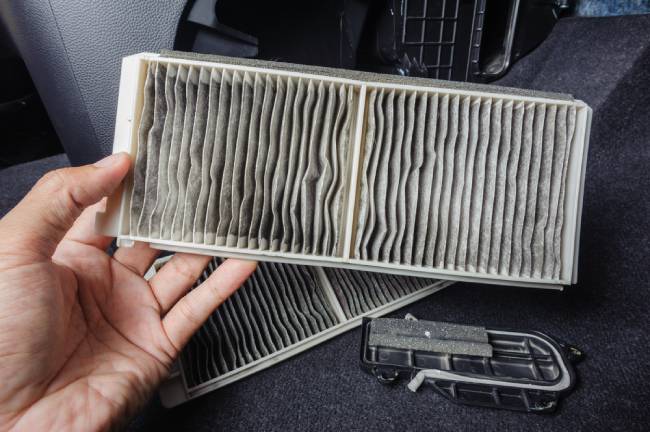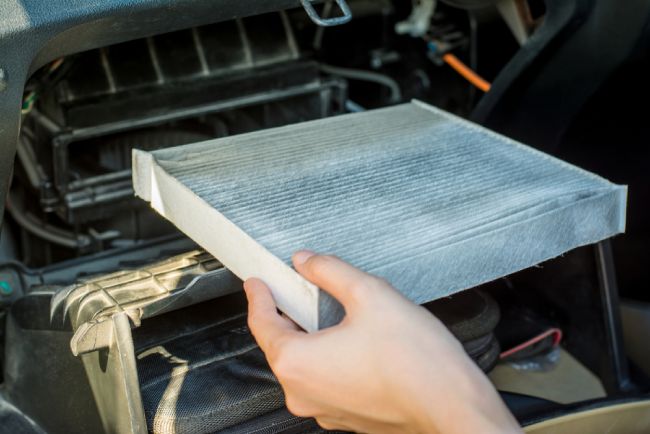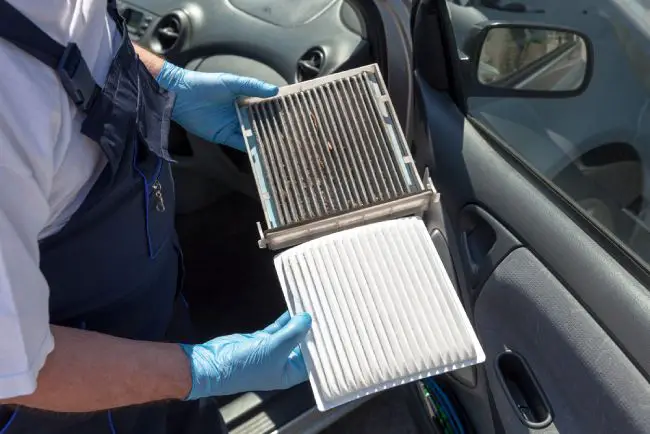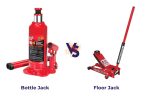Changing your cabin air filter roughly between 15,000-25,000 miles or at least once a year is a good rule of thumb.
But if you often drive through heavy traffic, dusty surroundings, or an area with lots of bushes around, consider checking the air filter every 4 to 6 months.
Signs of a Failing Cabin Air Filter

The cabin air filter snags and holds the contaminants and lets you breathe clean air inside your car. Over time, they fill up with dirt and pollutants and fail to serve their purpose.
You’ll notice a few things when it’s time to change your air cabin air filter. When these take place, Know that you need a replacement for the cabin air filter ASAP.
1. Low airflow through your ventilation system
This is one of the first signs that you need to replace your cabin air system right away. The eventual dust build-up on the filter causes your air conditioning to blow noticeably weakly.
2. Thick smell
The purpose of a cabin air filter is to protect you in the car from the outside particles and smells. But they stink when they are completely clogged.
3. Haze on the inside window
A clean cabin air filter maintains the airflow within the vehicle interior and prevents fog or dust from reaching you.
A failing filter, on the other hand, results in poor airflow and makes it difficult to remove moisture from the windows. Fog or dust inside or outside your car could cause a fatal accident.
4. Breathing issues when windows are closed
It’s normal to think of breathing issues when it’s time to change your cabin air filter. The air may not pass well or may pass with dust and dirt through the air conditioning vents, and you may suffer as you inhale or exhale.
5. Unpleasant whistling din from the vents
You may hear a constant whistle coming through air vents which can get pretty engagingly annoying at times.
How to Change a Cabin Air Filter
Changing a cabin air filter is one of the simplest tasks you will perform on your car and it requires no heavy tools.
These are the easiest steps you can use for convenience –
- Look into your owner’s manual to locate the cabin air filter in your car. It is typically behind the dashboard or under the hood.
- Get the toolbox ready and wear protection such as eye-glass, face mask, and hand gloves. In most cases, you only need a Phillips head screwdriver and a vacuum cleaner.
- Unscrew the glove box pins and carefully detach the glove box unit.
- When the glove box panel is open, You’ll see tabs on both ends of the cabin air filter case. Push the tabs inward and take the old cabin air filter out.
- Dry-clean the inside of the filter-casing area or vacuum it out if it seems dirty.
- Deliberately place the new filter in.
- Get your glove box back into position and screwed.
How Much Does Changing a Cabin Air Filter Cost?
A cabin air filter normally costs from $20 to $80 depending on the size of the piece. If you don’t do the replacement yourself, your labor fee will vary from garage to garage and mechanic to mechanic.
If you still have a warranty and plan to do the replacement in an official service center to the brand of your vehicle, the maintenance charge may be covered.
Some luxury brands may charge a lot for their parts and make you buy your cabin air filters only from them for quality. But if you recognize your thing, you may get a filter from your local auto shop with a lot less.
Note:
You only need to change your cabin air filter when it’s unusable and dirty. You don’t have to replace it at the recommendation of your mechanic every time you pay a visit to the garage. Give it a visual inspection first; if the cabin air filter looks still alright, you may wait for a later date.
What Happens if the Cabin Air Filter Isn’t Replaced?

A cabin air filter is the lungs of your vehicle’s interior and a dirty filter in your car can get you into trouble.
1. Health issues
Your cabin air filter must be perfectly functioning to provide fresh air for you to breathe inside your car.
The air cannot pass through a clogged or filled-up cabin air filter. It may cause serious difficulties for those with asthma, allergy, or breathing and sneezing problems.
Note:
Replace your cabin air filter every February just so you don’t often sneeze when the spring comes, especially if you live in a place with lots of trees around.
2. Damaged HVAC system
If you leave a cabin air filter in its place for more than you should, the HVAC system of your vehicle will fail.
An unclean cabin air filter decreases the amount of air flowing through the vents that influence the heater core, evaporator, and temperature in your cabin.
Before all these malfunctions happen to your car and cause your motor coil to flicker up, you might want to change your dirty cabin air filter with a pristine one.
3. Foul smell
A gross dusty stench is the most noticeable sign that you didn’t replace your cabin air filter on time. The smell predominantly thickens as you turn on the climate control of your vehicle.
4. Engine disaster
A spoiled cabin air filter makes your engine dirty and less efficient. It brings poor fuel economy and nasty emissions.
A dirty engine suffers to draw air into the combustion chambers, so the disruption of the gas to air ratio takes place. Your engine sounds rough when it gets a lot of gas but not sufficient air.
FAQs
1. Is it okay to drive without a cabin air filter?
Ans: It’s not okay to drive your car without a cabin air filter because of the long-term damages it may cause. However, your car will get faster as the airflow will increase.
2. How long do cabin air filters last in cars?
Ans: A cabin air filter will last approximately about one and a half years up to 25,000 miles at most. Check the owner’s manual to find out more on this matter about your particular make and model.










Leave a Comment